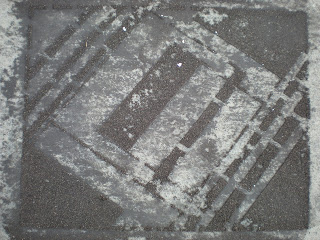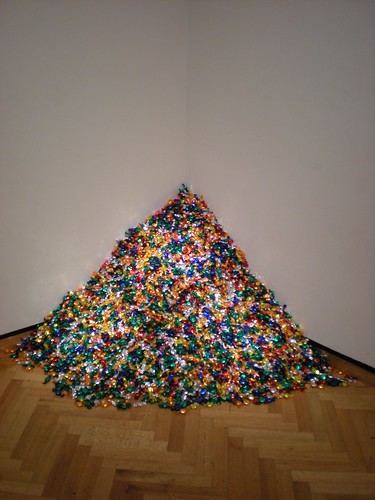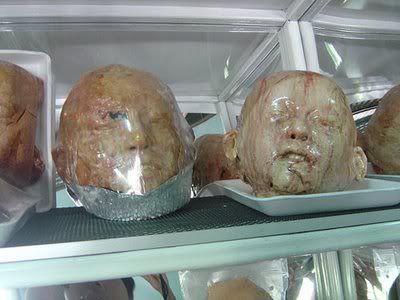












 In our discussions about alternate audiences for art, one thing we've considered is the idea that "social space" can be an intimate, specific gesture or a broader one aimed at a more generalized audience. As Justine, Tim, and several others have figured out as their projects develop, creating work for "the public" can be tricky: just because an audience has visual access to the work doesn't mean that they will feel any less alienated or irritated by it than work in a gallery space. They may, in fact, find it more so.
In our discussions about alternate audiences for art, one thing we've considered is the idea that "social space" can be an intimate, specific gesture or a broader one aimed at a more generalized audience. As Justine, Tim, and several others have figured out as their projects develop, creating work for "the public" can be tricky: just because an audience has visual access to the work doesn't mean that they will feel any less alienated or irritated by it than work in a gallery space. They may, in fact, find it more so. For those of you interested in street art, One Person's Vandalism is Another's Art defines some differences between traditional graffiti and more recent trends in street art, as well as some of the ways that the language of street art is being coopted by advertisers and even political campaigns... and more interestingly, the backlash against street art (and against street art-esque advertising) by other artists, leading back again to similar questions of audience. Should artists keep their art "to themselves," within sanctioned venues? Are there other, perhaps more interesting ways to engage the boundaries of place/space/audience? There are certainly worthwhile arguments both for and against this stance, and I'd be interested to hear your opinions.
For those of you interested in street art, One Person's Vandalism is Another's Art defines some differences between traditional graffiti and more recent trends in street art, as well as some of the ways that the language of street art is being coopted by advertisers and even political campaigns... and more interestingly, the backlash against street art (and against street art-esque advertising) by other artists, leading back again to similar questions of audience. Should artists keep their art "to themselves," within sanctioned venues? Are there other, perhaps more interesting ways to engage the boundaries of place/space/audience? There are certainly worthwhile arguments both for and against this stance, and I'd be interested to hear your opinions.

Anna Callahan is a community-based artist who focuses on creating art in public spaces. Her work evolves from informal interviews she has with strangers that she encounters in a community—such as a university, library, and city transit system. The conversations are centered around a particular topic respective to those public spaces. She records all conversations and creates visual and aural installations, which includes printed materials and listening stations to invite people to listen to someone whom they would otherwise never meet.


























While doing research for a bread-making project I had been working on recently (creating sourdough bread from a starter which included samples of my own vaginal yeast), I stumbled upon the work of Kittiwat Unarrom, an artist who creates body parts out of bread. I was interested in the implications of the human body providing food for itself, and though this is more figurative than my approach, the shock value of the work is undeniable. This Thai artist has been producing these gruesome looking works out of his family's bakery, making it a local attraction.
The work can be interpreted in a myriad of directions from political statements to religion to the desire or repulsion stemming from the idea of cannibalism.
His work is fully edible, and reportedly tastes like normal bread, though even with that knowledge, I wonder how many can work up the nerve to eat it?
 Well, I do anyway . . . through him. I took Sculpture I with Philip Matesic last spring and found several of his pieces that fit in pretty well with what we've been doing this semester. While there isn't a whole lot that's print-related, most of his work addresses social space and interaction. A couple of my favorites are titled "Stop Carrying Out Your Intentions and Watch for My Signals" and "I Wish To Communicate with You". For these, Philip constructed two shelters based on images from the International Code (a series of flags used for communication between mariners), installed them at various beaches in Denmark and let his audience do the rest. Not a bad way to spend a day at the beach. Click here to check out more of his work.
Well, I do anyway . . . through him. I took Sculpture I with Philip Matesic last spring and found several of his pieces that fit in pretty well with what we've been doing this semester. While there isn't a whole lot that's print-related, most of his work addresses social space and interaction. A couple of my favorites are titled "Stop Carrying Out Your Intentions and Watch for My Signals" and "I Wish To Communicate with You". For these, Philip constructed two shelters based on images from the International Code (a series of flags used for communication between mariners), installed them at various beaches in Denmark and let his audience do the rest. Not a bad way to spend a day at the beach. Click here to check out more of his work.
 Visiting the Three Walls gallery was really cool. I think my favorite part was the t-shirt printing! I was in awe of how many shirts there were, it must have taken them a really long time to make all the shirts. What I found most interesting was the range in craft. Some of the shirts were PERFECT, as I closely inspected some of them I did not see one printing flaw! I was in awe. But as I continued to walk around the walls of hanging shirt I started to see that the craft tended to vary, and some had some printing mistakes. But overall the shirts were really great, my favorite one was Rabbit Season and Duck Season, I wanted one! I even read the description, but didn't quite understand the reference to the election. In general I really enjoyed all three of the exhibits!
Visiting the Three Walls gallery was really cool. I think my favorite part was the t-shirt printing! I was in awe of how many shirts there were, it must have taken them a really long time to make all the shirts. What I found most interesting was the range in craft. Some of the shirts were PERFECT, as I closely inspected some of them I did not see one printing flaw! I was in awe. But as I continued to walk around the walls of hanging shirt I started to see that the craft tended to vary, and some had some printing mistakes. But overall the shirts were really great, my favorite one was Rabbit Season and Duck Season, I wanted one! I even read the description, but didn't quite understand the reference to the election. In general I really enjoyed all three of the exhibits!

 There are three shows at the Three Walls gallery. Holle Cambodia, Dispatch, and Tract House. Each is shown in a seperate room throughout the gallery. My favorite was the Tract House. In the back room there is a large table filled with zines of all sizes, colors, and content. I picked up one of each zine and read each one. It was intimidating at first, I honestly did not think i would gt through reading them all like i told myself to, but luckily I have a long train ride home. I ended up liking a lot of the reads. They ranged from promoting minamalist lifestyles, to religion, to cooking tips. Some of them were quite funny. The illustrations were interesting; politicians' heads on dinosaur bodies, greek gods, rolie polie men, and women from the fifties. I thought the most interesting part of this display was how the working was handed out. in class, we were to take our zines with a predetermined audience and disperse them, here, the artists (as written on the wall) are asking us to take these and do what we please with them, letting us pick and chose an audience for them.
There are three shows at the Three Walls gallery. Holle Cambodia, Dispatch, and Tract House. Each is shown in a seperate room throughout the gallery. My favorite was the Tract House. In the back room there is a large table filled with zines of all sizes, colors, and content. I picked up one of each zine and read each one. It was intimidating at first, I honestly did not think i would gt through reading them all like i told myself to, but luckily I have a long train ride home. I ended up liking a lot of the reads. They ranged from promoting minamalist lifestyles, to religion, to cooking tips. Some of them were quite funny. The illustrations were interesting; politicians' heads on dinosaur bodies, greek gods, rolie polie men, and women from the fifties. I thought the most interesting part of this display was how the working was handed out. in class, we were to take our zines with a predetermined audience and disperse them, here, the artists (as written on the wall) are asking us to take these and do what we please with them, letting us pick and chose an audience for them.
